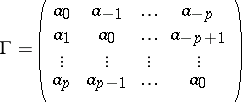Carathéodory-Toeplitz extension problem
Let  be given complex numbers. The Carathéodory–Toeplitz extension problem is to find (if possible) a function
be given complex numbers. The Carathéodory–Toeplitz extension problem is to find (if possible) a function  , analytic on the open unit disc
, analytic on the open unit disc  (cf. also Analytic function), such that
(cf. also Analytic function), such that
a)  ,
,  ;
;
b)  for all
for all  . Put
. Put  for
for  . The problem is solvable if and only if the Toeplitz matrix
. The problem is solvable if and only if the Toeplitz matrix
 | (a1) |
is positive semi-definite, and its solution is unique if and only if, in addition,  is singular (cf. also Degenerate matrix). The Carathéodory–Toeplitz extension problem can be restated as a Carathéodory–Schur extension problem. The Levinson algorithm from filtering theory provides a recursive method to compute the solutions of the problem. For these and related results, see [a1], Chapt. 2.
is singular (cf. also Degenerate matrix). The Carathéodory–Toeplitz extension problem can be restated as a Carathéodory–Schur extension problem. The Levinson algorithm from filtering theory provides a recursive method to compute the solutions of the problem. For these and related results, see [a1], Chapt. 2.
Instead of functions  satisfying a) and b), one may also seek functions
satisfying a) and b), one may also seek functions  ,
,  , in the Wiener algebra
, in the Wiener algebra  with the property
with the property  for every
for every  . (The Wiener algebra is defined as the Banach algebra of complex-valued functions on the unit disc having a Fourier series
. (The Wiener algebra is defined as the Banach algebra of complex-valued functions on the unit disc having a Fourier series
 |
using pointwise multiplication. The phrase "Wiener algebra" is also used for  with convolution as multiplication. There are also weighted versions; cf. [a2].)
with convolution as multiplication. There are also weighted versions; cf. [a2].)
In this case,  satisfies conditions a) and b). The Wiener algebra version of the problem is of particular interest if the solution
satisfies conditions a) and b). The Wiener algebra version of the problem is of particular interest if the solution  is required to be strictly positive on the unit circle
is required to be strictly positive on the unit circle  . The latter version of the problem is solvable if and only if the Toeplitz matrix
. The latter version of the problem is solvable if and only if the Toeplitz matrix  in (a1) is positive definite, and in that case there are infinitely many solutions
in (a1) is positive definite, and in that case there are infinitely many solutions  , given by
, given by
 | (a2) |
Here,  is an arbitrary function in the Wiener algebra
is an arbitrary function in the Wiener algebra  with
with  for every
for every  , and the functions
, and the functions  and
and  are uniquely determined by the data in the following way:
are uniquely determined by the data in the following way:
 |
 |
where
 |
The central solution  , which appears when the free parameter
, which appears when the free parameter  in (a2) is set to zero, is the unique solution
in (a2) is set to zero, is the unique solution  with the additional property that the
with the additional property that the  th Fourier coefficient of
th Fourier coefficient of  is equal to zero for
is equal to zero for  , and for this reason the central solution is also referred to as the band extension. The central solution
, and for this reason the central solution is also referred to as the band extension. The central solution  is also the unique solution
is also the unique solution  that maximizes the entropy integral
that maximizes the entropy integral
 |
Proofs of the above results may derived by applying the band method (see [a2], Sect. XXXV.3), which is a general scheme for dealing with a variety of positive and contractive (operator) extension problems from a unified point of view. (The word "band" refers to a decomposition of an algebra with involution, reminiscent of the use of bands as in the theory of decomposition or Riesz spaces (cf. Riesz space). It refers, in fact, to a "band pattern" , i.e. a band in a matrix  , cf. also Partially specified matrices, completion of.)
, cf. also Partially specified matrices, completion of.)
The Carathéodory–Toeplitz extension problem has natural generalizations for matrix- and operator-valued functions. The problem also has a continuous analogue (with the role of the open unit disc being replaced by the upper half-plane) and non-stationary versions for finite or infinite operator matrices.
References
| [a1] | C. Foias, A.E. Frazho, "The commutant lifting approach to interpolation problems" , Operator Theory: Advances and Applications , 44 , Birkhäuser (1990) |
| [a2] | I. Gohberg, S. Goldberg, M.A. Kaashoek, "Classes of linear operators" , II , Birkhäuser (1993) |
Carathéodory-Toeplitz extension problem. Encyclopedia of Mathematics. URL: http://encyclopediaofmath.org/index.php?title=Carath%C3%A9odory-Toeplitz_extension_problem&oldid=23228